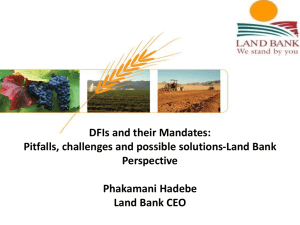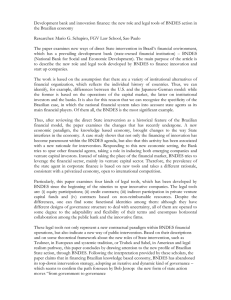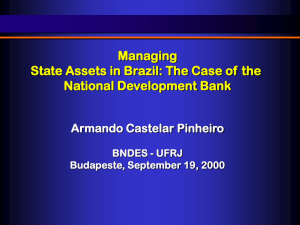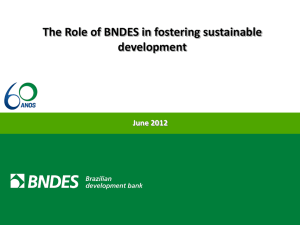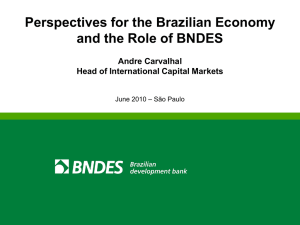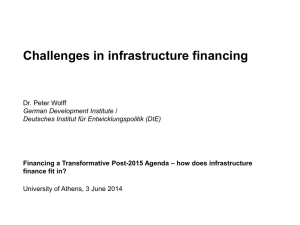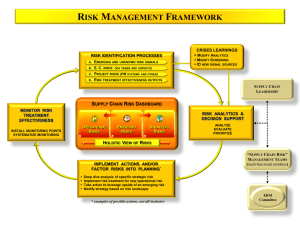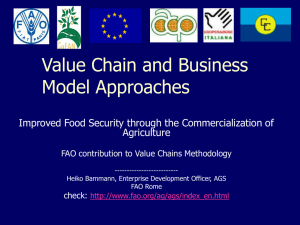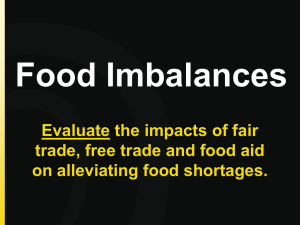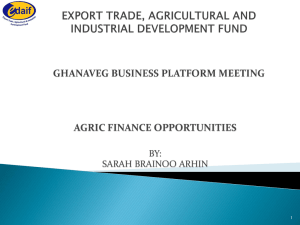AMT Presentation - DFIs and their Mandates-latest (12-09
advertisement
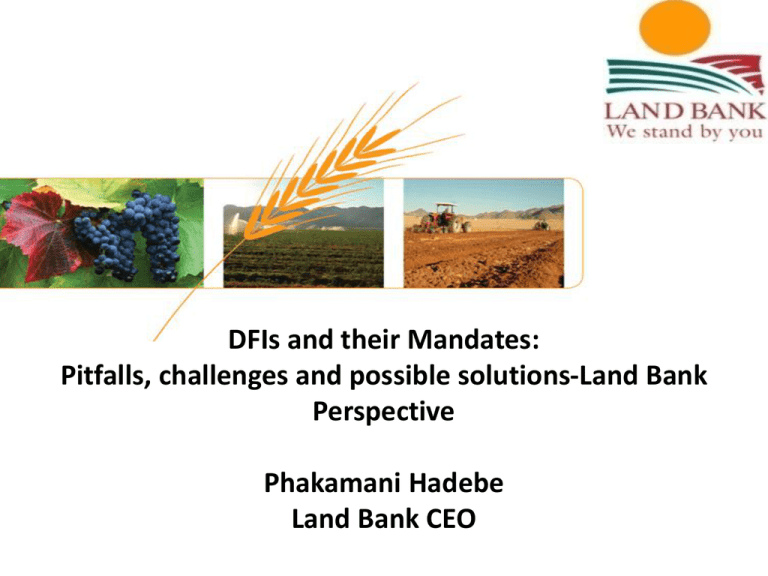
DFIs and their Mandates: Pitfalls, challenges and possible solutions-Land Bank Perspective Type Title here Hadebe Phakamani Land Bank CEO Growth in SADC and South Africa • wcqc Source: IMF Staff Estimates Growth in World Population • World ‘population peak’ expected in the next 4 decades; World Population 10,000,000 9,000,000 Number (million) 8,000,000 – How will the 9bn people be fed? 7,000,000 6,000,000 5,000,000 • But can the same be said of ‘meat or protein’ peak? 4,000,000 3,000,000 2,000,000 1,000,000 1961 Source: FAO 1972 1983 1994 2005 2016 2027 2038 2049 • And what are the implications for land, food and feed requirements? Similar Population growth pattern in SA Arable Land under Pressure The pressure of farm land reflected on farm land prices, which could not even yield to recession SA Land Price Index Source: 250.0 FAO (HLEF-2050), 2009 Index (2000=100) 200.0 150.0 100.0 50.0 0.0 1994 1998 2002 2006 2010 Source: FAO and DAFF Index A possible repeat of 2007/08 Food Price Shock? FAO Food Price Index 230 210 190 170 150 130 110 90 70 50 1990 2,500 1993 1996 1999 2002 2005 2008 • High food prices reversing the gains that have been made over the years towards the achievement of MDGs, • Also constraining the humanitarian aid in the Horn of Africa, currently gripped by hunger and famine; • Could this be a an indication of Malthusian crisis lacking in the shadow or results of political developments in the region? • Indeed Amartya Sen (Nobel Laureate) is of the view that ‘famine does not happen democracies’; • The tragedy is that small farmers are missing out on the opportunity to general windfall that can be used to reduce gearing. 2011 SAFEX Maize Price Trend Rand/ton 2,000 1,500 1,000 Yellow Maize 500 1-May-07 1-Jun-08 White Maize 3-Jul-09 4-Aug-10 5-Sep-11 Source: FAO and Grain SA Cost of intermediate goods and services Source: DAFF Transport and logistics cost • Fixed cost includes: depreciation, cost of capital, license, insurance and wages. • Running cost includes: fuel, oil, maintenance, tyres and incidental cost. Cost-Price Squeeze 295 Index: 2000=100 245 195 145 95 45 2010 2009 2008 2007 2006 Price index: All farming requisites 2005 2004 2003 2002 2001 2000 1999 1998 1997 Source: DAFF and Statistic South Africa 1996 1995 1994 1993 1992 1991 1990 PPI Net farm income and total farming debt Source: DAFF Within the above context, what is the role of a DFI? The Ideal World of Development Financing • DFIs require patient capital that can be invested for long term and possibly at concessionary rates; • Post-crisis involves more State and more Market sourcing of investible funds. – However, market sourcing removes the competitive advantage of a DFI as pricing converges to that of normal commercial banks and thus impacting on development funding • High food inflation highlighting the importance of more and better jobs. • DFIs that should be oriented for the long term and are essential vehicles for development financing. – Effectively, State outsourcers some of delivery priorities to DFIs • To be effective, DFIs must have the necessary means: financing tools, stable and sufficient resources; technical capabilities; close relationships with stakeholders. DFI in Brazil [The Brazilian Development Bank (BNDES)] BNDES Approvals and Disbursements US$ billion • A 100% State-owned company under private law established in 1952; • Main provider of longterm financing in Brazil; 100 Source: BNDES 90 Approvals 85.2 Disbursements 88.2 80 66.3 70 60 50.6 68.8 71.1 50.5 50 40 34.1 30 20 10 22.3 13.1 10.9 33.1 23.5 19.3 12.9 13.6 0 2003 2004 2005 2006 2007 2008 2009 2010* BNDES Funding Composition 100% 10% 90% 7% 80% 8% 70% 8% 12% 9% 9% 16% 7% 6% 6% 16% 60% 50% 40% 67% 30% 66% 53% 20% • Of significance is continued capital allocation from National Treasury, which increased during the crisis period; • 40% of institutional funding is from Worker Assistance Fund (FAT)- the local equivalence of UIF and is remunerated at long term interest rate (TJLP); 10% 0% 2006 Intitutional Source: BNDES 2007 National Treasury Foreign 2008 Others Equity • Combination of National Treasury grant funding together with FAT funding enables BNDES to offer concessionary funding. BNDES Disbursements by Business Sector 100% 7% 90% 7% 80% 70% 12% 12% 14% 8% 6% 5% 39% 35% 40% 43% 46% 2007 2008 2009 33% 60% 40% 50% 40% 30% 53% 20% 10% 0% 2006 Industry Source: BNDES Infrastructure Agriculture Trade and Services In line with the company’s strategic objectives Impact of BNDES on job creation Formal Jobs Creation (Million) 45 40 35 Millions 30 26.2 27.2 28.7 29.5 31.4 33.2 35.2 37.6 39.1 Exponential growth in job created through BNDES funding 25 20 15 10 5 0 2000 Source: BNDES 2001 2002 2003 2004 2005 2006 2007 2008 Ag DFIs in China and India National Bank of Agriculture and Agricultural Development Bank Rural Development of China • • • A 100% State-owned Bank Mandates of facilitating credit flow for promotion and development of agriculture and integrated rural development. Multiple sources of funding: – – – – Deposits; Borrowing from Government of India; Capital markets; Co-operative fund funded by commercial banks (i.e. NARBARD also act as an agency for scheduled commercial banks that are not achieving priority sector obligations). • • • A 100% State-owned Bank Also a policy bank with mandates; Multiple funding sources: – Generally issues bond, considered as safe as the Central Bank's bonds, since it is fully banked by the People's Central Bank of China (PBOC); The bottom line is that borrowing from government and Central Banks allows these SOEs to provide concessionary lending Focus on SA’s DFI DFIs in SA • SA has both National and Provincial DFIs, each with specific mandates – National DFIs • Land Bank • IDC • DBSA and others Capital Markets the primary source of funding but has tax concessions – Provincial DFIs • • • • Mega- Mpumalanga Limdev- Limpopo ECDC- Eastern Cape Ithala- KNZ and others Government the primary source of funding through provincial treasury departments Government Priorities • • • • • Education Fighting Crime Health Employment Rural Development Government’s Priorities • The SA-SAM (Social Accounting Matrix) quantify the circular flow of economic activity through the system of National Accounts in a matrix format • SAM estimates that for each R1m the Bank invests, 10.8 jobs are created compared to 5.7 jobs for mining • The South African economy (2010) achieves an average rate of 2.55 jobs per R1 million Government’s Priorities • Government willing to play a more visible role/developmental state • Government undertook DFI review • Creation of the DFI Council to report to Cabinet • New growth path emphasizes the importance of Rural Development Strategy • Planning Minister’s Diagnostics highlight the importance of Rural Development Land Bank Funding Sources • Unlike the provincial DFIs and BNDES we saw earlier, Land Bank is expected to source funding from the Capital Markets- the same pool used by commercial banks • The implication of the above is the convergence of risk appetite with those of the commercial banks. • This also means similar pricing structure to the detriment of emerging farmers and development. • Even if we want, obligations with capital markets constrains the Land Bank’s ability to provide concessionary and long tenor loans. • Even made more difficult as Land Bank is not a deposit taking institution. • In the end, constraints LB’s ability to deliver on the developmental state outcomes Hence the birth of REM Segment (ring-fenced) • Land Bank has launched the Retail Emerging Markets (REM) for dedicated attention to emerging farmers; • Working closely with government to ensure concessionary loans to this target market; • Some of the programs involving collaboration with government: – Value Chain Financing; – Curatorship Model; and – Collateral Guarantee Fund Several initiatives to implement • Implementation of the Cabinet approved Emerging Farmer Support Facility; • Disburse R1bn over next 2 years to emerging farmers via a new business unit focussing on emerging farmers • Targeting 30% of market share in the next 12-18 months Funding Model Government funding Land Bank Retail Emerging Markets (REM) BCB and RCB Land Bank Insurance Company (LBIC) % profit for development Multilateral Funding % profit for development Lending Model Retail Commercial Banking (RCB) – Previously :Retail Retail Emerging Markets to be funded by a combination of Government support and Value Chain Model Business and Corporate and Banking (B&CB), Previously : CFU The combined NPL’s for RCB and B&CB are 6.2%. Land Bank Retail Emerging Market Loan book =R1.0 Bn NPL =58 % Retail Commercial Banking Loan book =2.8 RBn NPL = 14% Borrowing for the purpose of funding commercial business Business and Corporate Banking Loan book = R11.4 Bn NPL = 5.8% Sustainable business model: Developing Farmers Support Facility Collateral (50% - 90% of loan value) Supplementary or Collateral Guarantee Fund Credit assesment Land Bank LB to negotiate partnership Additional support (Offtake agreement SCF, ARC, NAMC, Univ, DAFF, Insurance) Lending through LB branches, municipalities & Ext offices LB to negotiate partnership Eligible Borrowers (Farmers & agribusiness) Agric cooperatives (+intermediaries) Technical Support Sustainable business model: Wholesale Funding Facility CURRENT FUNDING MODEL Estimated cost to lend of 8% Financial markets Land Bank Intermediaries On-lend to intermediaries at 8%+ Lending from FM at 6%+ Pays approximately Prime +7% Emerging Farmers Cost of direct lending = 8% based on: * Assesment, *Operational cost, * Disbursement admin, * Provision of technical support * Bad debt provision * Own profit margin 2.75-3.75% 2.25% 2-3% GOVERNMENT SUPPORT MODEL: WHOLESALE FUNDING FACILITY Lending from FM at 6%+ Financial markets Farmers pays Prime minus 5% On-lend to intermediaries at 0% Land Bank On-lend to farmers at a 4% cap Intermediaries Reimburse 4% DAFF Reimburse 4% Emerging Farmers Conclusion • Agriculture entering what could be regarded as the ‘golden age’ of agriculture; • Characterised by high agricultural commodity prices; • The tragedy is that emerging farmers are once again likely going to miss out on the opportunity to generate windfalls; • Having realised the important of concessionary and long tenor loans, Land Bank working with government to ensure effective delivery of development mandates as contained in the Land Bank Act 2002. THANK YOU
